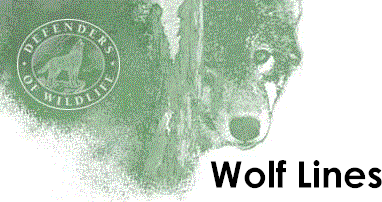

| The Bulletin of Wolf
Council December 15, 2000 Your Comments Are Needed to Help Wolves Return to the Southern Rockies Feasibility studies show that suitable habitat exists for wolves in the southern Rockies. On November 13, 2000, Defenders of Wildlife filed a petition with the U.S. Fish and Wildlife Service (FWS) to have the southern Rockies region declared its own distinct population segment for purposes of gray wolf recovery. To help enable wolf recovery in this area, Defenders of Wildlife has agreed to extend our wolf compensation trust to cover the southern Rockies region until wolves no longer require federal protection. Visit http://www.savewolves.org/ to learn more about what you can do to urge FWS to return wolves to the southern Rockies. A Second Idaho Wolf Found Dead The alpha male of the Smoky Mountain pack B-96 was found dead this week, marking the second confirmed wolf killing in less than a month in the area of Camas County, Idaho. B-57, a large male of the same pack, was found shot to death in late November. There is no evidence that these two wolves were involved in harming any livestock. Defenders of Wildlife joined the U.S. Fish and Wildlife Service in offering a $4,000 reward for information leading to the arrest and conviction of the person or persons responsible for the killings. The body of B-96 was recovered near Lick Creek on December 4, having suffered a fatal gunshot wound. B-57 was discovered shot to death in the Willow Creek drainage, near a frequently used hunting road. It had been dead as long as two weeks. B-57 was a three-year-old wolf with a dark black coat. He had recently left his Thunder mountain pack near McCall, Idaho and joined the Smoky Mountain pack near Fairfield. Aerial monitoring by the Nez Perce Tribe last picked up the signal from B-57's radio collar on November 7, 2000, at which point the wolf was alive and active. The killing of an animal protected under the Endangered Species Act is punishable by a fine of up to $100,000 and one year in jail. FWS has requested that anyone with information regarding the killings contact law enforcement agents immediately at 208-378-5333. Proactive Measures Taken To Prevent Wolf - Livestock Depredation Wolf-livestock conflicts are one of the biggest obstacles to successful wolf reintroduction programs. Although livestock predation by wolves has been minimal. Instances of wolf kills have been widely publicized and can contribute to a negative public perception. In addition to compensating ranchers for verified livestock losses attributed to wolves, Defenders of Wildlife is active in pursuing measures to prevent wolf-livestock depredation in the first place. Research into proactive non-lethal methods began a few years ago. In January 1999 Defenders began to experiment with livestock guarding dogs, wolf guardians, electric fences and alternative grazing pastures. Defenders is committed to changing perceptions when it comes to wolf threats on livestock populations. We believe that wolves and livestock can coexist. See below for a list of non lethal techniques sponsored by Defenders of Wildlife.
Total expenditures: $ 11, 436. Agency Cooperators for these projects:
Carnivores 2000 Participant Surveys are Evaluated Close to 650 people attended Carnivores 200, Defenders of Wildlife's predator conference held in Denver, CO, November 12 through 15. We received many participant surveys from the Carnivores 2000 and we would like to thank everyone who returned completed surveys. The responses were overwhelmingly positive, and we appreciated learning what you liked about the conference. We also value the opportunity to consider suggestions for improvement when planning the next conference, in hopes of making it even more successful than this one. Your comments and concerns are taken seriously and will work to include these ideas in our conference planning. We look forward to seeing all of you again at Carnivores 2002, to be held in California November, 2002. We'd still like to hear from you, so if you haven't returned your form feel free to e-mail us suggestions at carnivores2000@defenders.org.
WolfLines is a bulletin of Defenders of Wildlife designed to serve wolf organizations and advocates. Bulletins are for informational purposes only and do not necessarily represent the positions of all organizations. © Defenders of Wildlife 2000 |